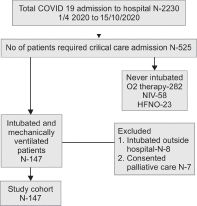Timing of Invasive Mechanical Ventilation and Mortality among Patients with Severe COVID-19-associated Acute Respiratory Distress Syndrome
- PMID: 34177166
- PMCID: PMC8196392
- DOI: 10.5005/jp-journals-10071-23816
Timing of Invasive Mechanical Ventilation and Mortality among Patients with Severe COVID-19-associated Acute Respiratory Distress Syndrome
Abstract
Background: Severe acute respiratory distress syndrome associated with coronavirus disease-2019 (COVID-19) (CARDS) pneumonitis presents a clinical challenge as regards to the timing of intubation and ambiguity of outcome. There is a lack of clear consensus on when to switch patients from trials of noninvasive therapies to invasive mechanical ventilation. We investigated the effect of the timing of intubation from the time of admission on the clinical outcome of CARDS.
Aim and objective: The aim and objective was to analyze the effect of timing of intubation early (within 48 hours of admission to critical care unit) versus delayed (after 48 hours of admission to critical care unit) on mortality in severe CARDS patients.
Materials and methods: A retrospective observational study performed in a 28-bedded COVID-19 intensive care unit of a tertiary care hospital in Pune, India. All patients admitted between April 1, 2020, and October 15, 2020, with confirmed COVID-19 (RT-PCR positive) requiring mechanical ventilation were included in the study.
Results: The primary outcome was in-hospital mortality. Among 2,230 patients that were admitted to the hospital, 525 required critical care (23.5%), invasive mechanical ventilation was needed in 162 patients and 147 (28%) of critical care admission were included in the study cohort after exclusion. Seventy-five patients (51%) were intubated within 48 hours of critical care admission (early group) and 72 (48.9%) were intubated after 48 hours of critical care admission (delayed group). With regards to the total of 147 included patients; male patients were 74.1% with a median age of 59 years (interquartile range, 51-68 years). Diabetes (44.9%) and hypertension (43.5%) were the most common comorbidities. Higher admission acute physiology and chronic health evaluation II scores and lower absolute lymphocyte count were observed in patients intubated within 48 hours. The early intubated group had a mortality of 60% whereas the same was observed as 77.7% in delayed intubation group, and this difference was statistically significant (p = 0.02).
Conclusion: Current study concludes that early intubation is associated with improved survival rates in severe CARDS patients.
How to cite this article: Zirpe KG, Tiwari AM, Gurav SK, Deshmukh AM, Suryawanshi PB, Wankhede PP, et al. Timing of Invasive Mechanical Ventilation and Mortality among Patients with Severe COVID-19-associated Acute Respiratory Distress Syndrome. Indian J Crit Care Med 2021;25(5):493-498.
Keywords: Acute respiratory distress syndrome; COVID-19; Intubation; Mechanical ventilation; Mortality.
Copyright © 2021; Jaypee Brothers Medical Publishers (P) Ltd.
Conflict of interest statement
Source of support: Nil Conflict of interest: None
Figures
References
-
- Matta SK. Dilemmas in Covid-19 respiratory distress: early vs late intubation; high tidal volume and low PEEP vs traditional approach? J Intensive Crit Care. 2020;6(2):7. doi: 10.36648/2471-8505.6.2.7. DOI: - DOI
LinkOut - more resources
Full Text Sources
Miscellaneous

